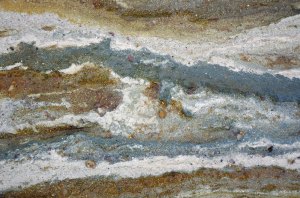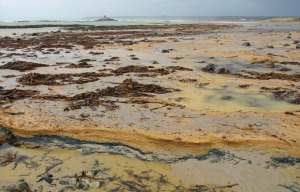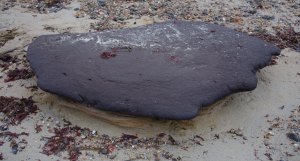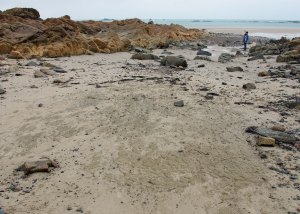At the start of the year we had the storm “Hercules” that gave the US severe weather conditions arrive on our shore, coupled with spring tides of 11.7 metres this made from some intense beach movement, this was evident mostly on the west and south coast, the following photographs detail some of the exposure:
Pictured above is part of a length of clay than lines the south east coast, this bit by Le Hurel slip appears unique in that it has either a drainage ditch or early field boundary (or both), the Societe Jersiaise archaeologist Robert Waterhouse and his team did some excavations on the area and a report will be published shortly.
I had been informed that some peat had been previously seen in the Greve D’Azzette area and had a look and only found this small exposure of a tan coloured clay which is similar to finds elswehere in the island and Les Ecrehous.
Pictured above is part of a small area uncovered by the foot of steps at Havre des Pas which was a mixture of tan and grey clay.
I was informed of an interesting exposure at La Pulente and it turned out to be one of the more interesting that I have seen in that it was lower down the beach compared to other exposures, I suppose being part of the headland may have something to do with this. I am not sure if the colours of clays and grits on these base layers as pictured are this colour naturally or have been stained by the rotting kelp that accumulates in the area, but they make pretty images if nothing else.
Also interesting is that this gritty base layer is just that a base and usually associated with start of our early ice age geology, but here we have the addition of another darker gritty layer.
I was lucky enough to see these exposure which only showed for a couple of days and had hoof prints and cart tracks which I presume are from 19th century vraicking attivity that the area is well known for, so it would appear this clay has shown little or not at all over the last hundred and fifty years or so.
This small piece of worn peat is part of the La Pulente clay area with the lighter clay just visible below it.
Further up the beach north of the Bunker a large area of hard base grit was uncovered there was no other signs of any other layers in the area.
I will do another post on the peat found in the bay.









[…] https://jouault.wordpress.com/2014/01/30/hercules-reveals-ancient-peat-and-clay-on-the-beaches/ […]